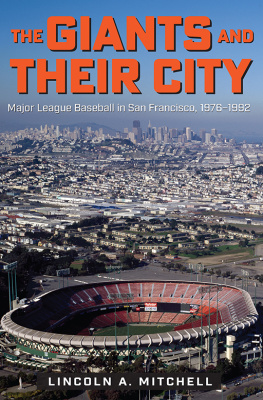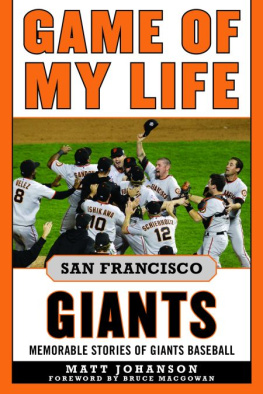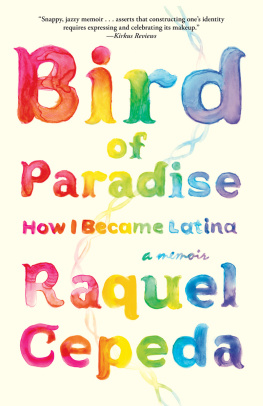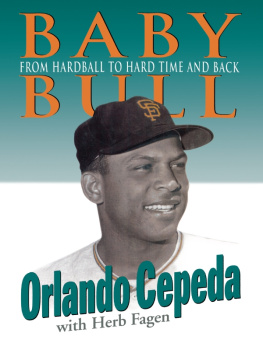THE ORLANDO CEPEDA STORY
BRUCE MARKUSEN

This volume is made possible through grants from the Andrew W. Mellon Foundation and the City of Houston through The Cultural Arts Council of Houston, Harris County.
Piata Books are full of surprises!
Piata Books
An imprint of
Arte Pblico Press
University of Houston
452 Cullen Performance Hall
Houston, Texas 77204-2174
Cover design Ken Bullock
Cover photo courtesy of San Francisco Giants/Archives
Markusen, Bruce.
The Orlando Cepeda Story / by Bruce Markusen.
p. cm.
Includes bibliographical references (p.) and index.
ISBN 1-55885-333-2
1. Cepeda, Orlando. 2. Baseball playersPuerto RicoBiography.
I. Title.
GV865.C4 M37 2001
796.357092dc21
 The paper used in this publication meets the requirements of the American National Standard for Information SciencesPermanence of Paper for Printed Library Materials, ANSI Z39.48-1984.
The paper used in this publication meets the requirements of the American National Standard for Information SciencesPermanence of Paper for Printed Library Materials, ANSI Z39.48-1984.
2001 by Bruce Markusen
Printed in the United States of America
1 2 3 4 5 6 7 8 9 0 10 9 8 7 6 5 4 3 2 1
This book is dedicated to Rosa Miranda,
who always showed care and love in
raising me from my youngest days.
Thank you, Rosa.
Contents
Introduction
Orlando Cepeda has experienced one of the most storied lives in baseball history. During his six stops in the major leagues, he played with sixteen Hall of Famers, a simply remarkable total. The lengthy list of legends included Hank Aaron and Willie Mays, arguably the two greatest players of the 1960s, and Bob Gibson and Juan Marichal, two of the eras hallmark pitchers.
While many Hall of Famers played for only two or three teams during their careers, Cepeda lived a far more diversified baseball life. In 1958, he made his major league debut with the San Francisco Giants, the first of his half-dozen big league teams. During his nine-year stay in the Bay Area, he played with future National League president Bill White and four eventual members of the Hall of Fame: Marichal, Mays, Willie McCovey, and Gaylord Perry. A trade in the middle of the 1966 season sent him to the St. Louis Cardinals, where he played with the Hall of Fame likes of Gibson, Lou Brock, and Steve Carlton, and became friendly with such notables as Curt Flood, Roger Maris, and Tim McCarver. Flood ended up challenging baseballs controversial reserve clause, which indirectly led to the start of free agency. Maris held the record for most home runs in a single season until Mark McGwire and Sammy Sosa came along. And McCarver went on to become one of the most successful broadcasters in baseball.
After a short stint in St. Louis, the Cardinals traded Cepeda to the Atlanta Braves for Joe Torre, a fine player who would become even more famous as the manager of the world champion New York Yankees. Cepeda batted behind Hank Aaron in a stacked Braves lineup, while also offering support to the teams knuckleballing right-handers Phil Niekro and Hoyt Wilhelm. In 1972, chronic knee problems and a dispute with Atlanta management led to a trade to the Oakland Asthis time in exchange for a talented but troubled pitcher named Denny McLain. Although Cepeda came to bat only a few times for the As, he did share roster space with three more legends of the game: Reggie Jackson, Jim Catfish Hunter, and Rollie Fingers. While in Oakland, he also played for one of the eras most successful managers (Dick Williams) and perhaps its most controversial owner (Charlie Finley).
Just when his career seemed at a standstill, the Boston Red Sox signed Cepeda to be their first designated hitter, allowing him to play a full season with the likes of Luis Aparicio, Carlton Pudge Fisk, and Carl Yastrzemski. The following year, a surprising spring training release led to his final major league stopthe Kansas City Royals. Just as Cepeda was saying good-bye to the game, he was also saying hello to a player named George Brett, a rookie third baseman struggling to find his way. Brett would become one of the greatest hitters of his era on his way to entering the Hall of Fame.
Having played with and against so many well-known players, Orlando Cepeda has seen just about everything during his career in baseball. Off the field, he encountered an even wider range of experiences: poverty, racism, culture shock, drug problems, prison, several marriages, and a life-changing religious conversion. Through it all, he continued to learn about othersand himself. His storyas rich and full as it has beenis one that we can learn from, too.
Chapter One
Birth of The Baby Bull
Pedro Anbal Perucho Cepeda was one of the finest-hitting shortstops to play on the island of Puerto Rico. He twice led the Puerto Rican Winter League in batting. In 1941, he hit .423 while leading the league in runs batted in (RBIs). The following season, he connected at a .464 clip, a simply remarkable batting average. He won several home run titles. He hit the ball so powerfully that some people called him the Babe Ruth of Puerto Rico, or the Babe Ruth of the Caribbean. Pedro grew into such a fearsome hitter that the New York Cubans, a well-respected team in the old Negro Leagues, repeatedly recruited him to play for them. The dark-skinned Cepeda said no. He didnt like the racial conditions that existed on the United States mainland. He didnt feel it was fair to exclude black players from performing in the major leagues, a situation that existed until 1947.
As a result, Pedro continued to play on the island. He remained a devastating hitter, even into his forties. And even playing against major league competition. One year, the New York Yankees visited Puerto Rico to play a series of exhibition games. Pedro Cepeda had to face Allie Reynolds and Vic Raschi, two of the top pitchers in the American League. In four at-bats against Reynolds and Raschi, the forty-something Cepeda stroked four consecutive hits.
As he grew older, Cepeda also maintained his competitive streak, which was legendary on the island. So determined to win, Pedro once pulled off an amazing play that still seems unbelievable to this day. With a man at third base and one out, Pedro sensed that the other team was planning a squeeze bunt to bring the runner home. As the pitch was delivered, Pedro charged in from his position at shortstop. Sure enough, the batter laid down the bunt as the runner from third raced home. Pedro pounced on the bunt and tagged the runner, whom he had beaten to the plate. Not hesitating for a moment, he then spun his body and fired the ball to first base. The throw beat the batter to the base, completing the double play. Simply incredible.
Fans and friends of Pedro called him Perucho, a Spanish nickname that has no literal translation or meaning in English. They also called him The Bull because of his stocky, five-foot, eleven-inch, 200-pound build and his ability to hit the ball with power into the outfield gaps. So, it was only natural that his son would draw the nickname The Baby Bull. Yet, no one could have known that Perucho Cepedas son would become even more famous in the United States than his legendary father.
On September 17, 1937, The Baby Bull was born in the city of Ponce. Perucho and his wife Carmen named their boy Manuel Orlando Cepeda y Pennes. (Pennes was the maiden name of Orlandos mother; in Puerto Rico, it is customary to attach the mothers maiden name to the childs last name.) In common everyday use, the name would be shortened to Orlando Cepeda. It was a beautiful name, one that flowed from the lips.











 The paper used in this publication meets the requirements of the American National Standard for Information SciencesPermanence of Paper for Printed Library Materials, ANSI Z39.48-1984.
The paper used in this publication meets the requirements of the American National Standard for Information SciencesPermanence of Paper for Printed Library Materials, ANSI Z39.48-1984.